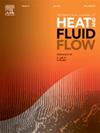Effects of the Weber number and structural parameters on combustion characteristics of LOX/methane liquid–liquid swirl coaxial injectors
IF 2.6
3区 工程技术
Q2 ENGINEERING, MECHANICAL
International Journal of Heat and Fluid Flow
Pub Date : 2025-03-20
DOI:10.1016/j.ijheatfluidflow.2025.109817
引用次数: 0
Abstract
LOX/methane engines have the advantages of a rich source, good cooling performance, low combustion temperature, difficult coking, etc., and a broad application prospect in reusable liquid rocket engines. Reasonable injector design is the key to organizing efficient and stable combustion of the engine. Among various types of injectors, the liquid–liquid swirl coaxial injector is widely used in a variety of two-component liquid rocket engines for its good atomization and high mixing efficiency. In order to comprehensively study the influence of multiple factors on combustion characteristics of LOX/methane liquid–liquid swirl coaxial injection, a 3-D combustion simulation model based on the improved 6-step mechanism is established. The simulation results of the Weber number show that when the ɷ (the Weber number ratio of methane to LOX) is in the range of 0.71 ∼ 2.64, the longest combustion length is found for ɷ of 1.36. Decreasing or increasing either propellant Weber number will shorten the combustion length. Further, combustion efficiency increases with increment of mixing ratio as well as decreasing ɷ. The simulation results of the structural parameters show that the combustion efficiency increases as the geometric characteristic coefficient (in the range of 0.5 ∼ 2.5) of the inner injector and the recess length (in the range of 0.42 ∼ 2.1) grow. The same rotation of the inner and outer injectors can effectively shorten the combustion length, but the reverse rotation has a higher combustion efficiency. The work can provide a theoretical basis for the optimal design of LOX/methane liquid–liquid swirl coaxial injectors and support the development of high-performance reusable LOX/methane engines.
求助全文
约1分钟内获得全文
求助全文
来源期刊

International Journal of Heat and Fluid Flow
工程技术-工程:机械
CiteScore
5.00
自引率
7.70%
发文量
131
审稿时长
33 days
期刊介绍:
The International Journal of Heat and Fluid Flow welcomes high-quality original contributions on experimental, computational, and physical aspects of convective heat transfer and fluid dynamics relevant to engineering or the environment, including multiphase and microscale flows.
Papers reporting the application of these disciplines to design and development, with emphasis on new technological fields, are also welcomed. Some of these new fields include microscale electronic and mechanical systems; medical and biological systems; and thermal and flow control in both the internal and external environment.
 求助内容:
求助内容: 应助结果提醒方式:
应助结果提醒方式:


